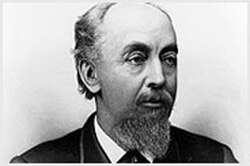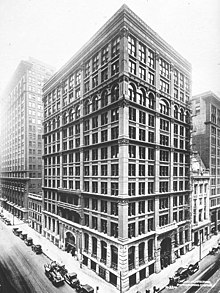William Le Baron Jenney
William LeBaron Jenney | |
|---|---|
 | |
| Born | September 25, 1832 |
| Died | June 15, 1907 (aged 74) |
| Nationality | American |
| Alma mater | École Centrale Paris |
| Occupation | Architect |
| Buildings | Home Insurance Building in Chicago |
| Design | metal-framed skyscraper |
William Le Baron Jenney (September 25, 1832 – June 14, 1907) was an American architect and engineer who is known for building the first skyscraper in 1884 and became known as the Father of the American skyscraper.
In 1998, Jenney was ranked number 89 in the book 1,000 Years, 1,000 People: Ranking the Men and Women Who Shaped the Millennium.
Life and career[]
Jenney was born in Fairhaven, Massachusetts on September 25, 1832, son of William Proctor Jenney and Eliza LeBaron Gibbs. Jenney began his formal education at Phillips Academy, Andover, in 1846, and at the Lawrence Scientific school at Harvard in 1853, but transferred to École Centrale des Arts et Manufactures (École Centrale Paris) to study engineering and architecture.[1]

At École Centrale Paris, he learned the latest iron construction techniques as well as the classical functionalist doctrine of Jean-Nicolas-Louis Durand (1760-1834) - Professor of Architecture at the Ecole Polytechnique.[1] He graduated in 1856, one year after his classmate, Gustave Eiffel, the designer of the Eiffel Tower. [7]
In 1861, he returned to the US to join the Union Army as an engineer in the Civil War, designing fortifications for Generals Sherman and Grant.
Union Engineers were called upon to construct a new road that stretched from Young’s Point to Bowers’ Landing, on the Louisiana shore below Warrenton. This would shorten the distance that rations and ammunition must be hauled to only eight miles. It would also free up the infantrymen guarding the supply line whose service was needed elsewhere, and establish both terminals under the protection of U.S. naval forces. The task was assigned to Capt. William L. B. Jenney, who served as chief engineer of Sherman’s XV Corps. To his dismay, Jenney realized that the entire eight mile route had to be bridged or corduroyed, as in many places the water was two feet deep. Work on the road began May 10 as a regiment of troops and detachment of pioneers labored under Jenney’s direction. The following day, Maj. William Tweeddale arrived with three companies of Bissell’s Engineer Regiment of the West to assist in opening the road. Thanks to the strenuous efforts of these men, wagons were able to roll over the road by 10 a.m. on May 12. [2]
By the end of the war, he had become a major, and was Engineer-in-Charge at Nashville's Union headquarters.[1] After the war, in 1867, Jenney moved to Chicago, Illinois and began his own architectural office, which specialized in commercial buildings and urban planning.
During the late 1870s, he commuted weekly to Ann Arbor, Michigan to start and teach in the architecture program at the University of Michigan. In later years future leaders of the Chicago School like Louis Sullivan, Daniel Burnham, William Holabird, and Martin Roche, performed their architectural apprenticeships on Jenney's staff.[1] On May 8, 1867, Jenney and Elizabeth "Lizzie" Hannah Cobb, from Cleveland, Ohio were married.[7] They had two children named Max and Francis.[7]

Jenney was elected an Associate of the American Institute of Architects in 1872, and became a Fellow in 1885. He served as first Vice President from 1898 to 1899.[4] In Chicago he designed the Ludington Building and Manhattan building, both built in 1891 and National Historic Landmarks. He also designed the for the World's Columbian Exposition (1893) held in Chicago.
Advent of the steel-frame skyscraper[]
Jenney is best known for designing the ten-story Home Insurance Building in Chicago. The building was the first fully metal-framed building, and is considered the first skyscraper. It was built from 1884 to 1885, enlarged by adding two stories in 1891, and demolished in 1931.[3] In his designs, he used metal columns and beams, instead of stone and brick to support the building's upper levels.

The steel needed to support the Home Insurance Building weighed only one-third as much as a ten-story building made of heavy masonry.[3] Using this method, the weight of the building was reduced, thus allowing the possibility to construct even taller structures. Later, he solved the problem of fireproof construction for tall buildings by using masonry, iron, and terra cotta flooring and partitions. In the years from 1889 to 1891, he displayed his system in the construction of the Second Leiter Building, also in Chicago.
According to popular story, one day he came home early and surprised his wife who was reading. She put her book down on top of a bird cage and ran to meet him. He strode across the room, lifted the book and dropped it back on the bird cage two or three times. Then, he exclaimed: "It works! It works! Don’t you see? If this little cage can hold this heavy book, why can’t an iron or steel cage be the framework for a whole building?" Jenney applied his new idea to the construction of the Home Insurance Building, the first skyscraper in the world, which was erected in 1884 at the corner of LaSalle and Monroe Streets in Chicago. Another source cites the inspiration for the steel skyscraper as coming from vernacular Philippine architecture, where wooden framed construction gave Jenney the idea.[4] The Home Insurance Building was the first example of a steel skeleton building, the first grid of iron columns, girders, beams and floor joists ever constructed.[citation needed]
Legacy[]
He died in Los Angeles, California, on June 15, 1907. After Jenney's death, his ashes were scattered over his wife's grave, just south of the Eternal Silence section of Uptown's Graceland Cemetery.[5] In 1998, Jenney was ranked number 89 in the book 1,000 Years, 1,000 People: Ranking the Men and Women Who Shaped the Millennium.[7]
Original notes and papers of Jenney, including "Jenney's 1884 holograph notebook containing, among other things, structural calculations for the Home Insurance Building, and his undated sketch entitled 'Key to the sky scraper.'", are held by the Art Institute of Chicago.[5]
Projects[]

- 19 South LaSalle Street, 1893, downtown Chicago
- , Hyde Park, Chicago, built in 1869
- , 770 Main St, Lake Geneva, Wisconsin, built in 1874, NRHP-listed[6]
- First Congregational Church (Manistee, Michigan), built in 1892 or 1888
- Home Insurance Building, Chicago, built in 1884
- , for the World's Columbian Exposition, Chicago, built in 1893
- Lake Forest Cemetery, Lake Forest, Illinois
- Ludington Building, Chicago, built in 1891, National Historic Landmark
- L.Y. Schermerhorn Residence, 124 Scottswood Road, Riverside, Illinois, built in 1869
- Manhattan Building, Chicago, built in 1891, National Historic Landmark
- New York Life Insurance Building, Chicago, built in 1894
- Second Leiter Building, Chicago, built in 1889
- West Park District section of Chicago's boulevard system
- DKE Shant, Ann Arbor, Michigan, 1878
- Part or all of Garfield Park, 100 N. Central Park Ave., Chicago, NRHP-listed
- Part or all of Humboldt Park, roughly bounded by N. Sacramento and Augusta Blvds., and N. Kedzie, North and N. California Aves. and W. Division St., Chicago, NRHP-listed
- Illinois Memorial, Vicksburg National Military Park, 1906
References[]
- ^ http://www.visual-arts-cork.com/architecture/william-le-baron-jenney.htm
- ^ The Engineers at Vicksburg https://www.erdc.usace.army.mil/Media/News-Stories/Article/1079633/the-engineers-at-vicksburg-part-17-the-logistician-and-the-architect/. Retrieved April 17, 2021. Missing or empty
|title=(help) - ^ Architecture and Building. XII (1): 5–6. January 4, 1890. Missing or empty
|title=(help) - ^ Condit C., The Chicago School of Architecture. A History of Commercial and Public Building, Chicago, The University of Chicago Press, 1964, Chapter 4, "Jenney and the New Structural Technique," p. 81.
- ^ "Elmer C. Jensen Papers, 1871-2014 (bulk 1880s-1950s)". Art Institute of Chicago. 2012. Retrieved May 22, 2019. Finding aid, including biographical info on William Le Baron Jenney and Elmer C. Jensen, published 2012.
- ^ Carol Lohry Cartwright (2001). "National Register of Historic Places Registration: Main Street Historic District (Lake Geneva)". National Park Service. Retrieved April 6, 2018.
Notes
- ^ Haden, Erik. "William LeBaron Jenney". Structural Engineers Association of Texas. Archived from the original on May 19, 2005. Retrieved December 17, 2005.
- ^ "Home Insurance Building". PBS Big Building Databank. Retrieved December 17, 2005.
- ^ "Graceland Cemetery". Graveyards of Chicago. Retrieved December 17, 2005.
Further reading
- Turak, Theodore (1986). William Le Baron Jenney: A Pioneer of Modern Architecture (Architecture and Urban Design, No 17). Umi Research Pr. ISBN 0-8357-1734-8.
External links[]
| Wikimedia Commons has media related to William Le Baron Jenney. |
- Chicago school architects
- Phillips Academy alumni
- 1832 births
- 1907 deaths
- Harvard School of Engineering and Applied Sciences alumni
- École Centrale Paris alumni
- 19th-century American architects
- American expatriates in France
- Architects from Massachusetts
- Taubman College of Architecture and Urban Planning faculty
- Fellows of the American Institute of Architects
- People from Fairhaven, Massachusetts
- Skyscraper architects